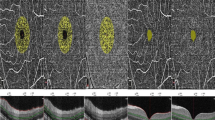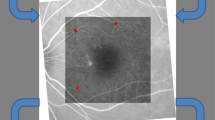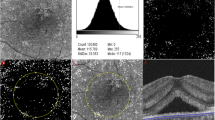Abstract
Using optical coherence tomography angiography (OCTA), we sought to evaluate parafoveal vascular density (VD) in patients with central serous chorioretinopathy (CSCR). Our study included 43 patients with a diagnosis of CSCR and 40 healthy controls. Ophthalmologic examination findings and OCTA measurements of the participants were retrospectively analysed. Of the 43 patients with CSCR, 31 were males (72%) and 12 were females (28%); the control group was 30 males (75%) and 10 females (25%) (p = 0.657). There were significant differences between affected eyes, unaffected eyes and healthy control eyes for all parameters in the superficial capillary plexus (SCP) VD and deep capillary plexus (DCP) VD (p < 0.05 for all values). It was also determined that the affected eyes had lower SCP-VD and DCP-VD than the unaffected eyes and that the unaffected eyes had lower SCP-VD and DCP-VD than the healthy control eyes (p < 0.05 for all values). While there were no significant differences in the deep foveal avascular zone (FAZ) area, the superficial FAZ area was larger in affected eyes than in both unaffected eyes and healthy control eyes (p < 0.05). In most areas, the SCP-VD and DCP-VD values were lower and the FAZ larger in the chronic group than in the acute group (p < 0.05). Retinal vascular changes were found in patients with both acute and chronic CSCR, and the fellow eyes of these patients were also affected. OCTA can therefore be considered an easily applicable, non-invasive screening option for evaluating the microvascular structure in these patients.


Similar content being viewed by others
References
Kitzmann AS, Pulido JS, Diehl NN, Hodge DO, Burke JP (2008) The incidence of central serous chorioretinopathy in Olmsted County, Minnesota, 1980–2002. Ophthalmology 115(1):169–173
Bennett G (1955) Central serous retinopathy. Br J Ophthalmol 39(10):605
Imamura Y, Fujiwara T, Margolis RON, Spaide RF (2009) Enhanced depth imaging optical coherence tomography of the choroid in central serous chorioretinopathy. Retina 29(10):1469–1473
Daruich A, Matet A, Dirani A, Bousquet E, Zhao M, Farman N, Jaisser F, Behar-Cohen F (2015) Central serous chorioretinopathy: recent findings and new physiopathology hypothesis. Prog Retin Eye Res 48:82–118
Tittl MK, Spaide RF, Wong D, Pilotto E, Yannuzzi LA, Fisher YL, Sorenson JA (1999) Systemic findings associated with central serous chorioretinopathy. Am J Ophthalmol 128(1):63–68
Bouzas EA, Karadimas P, Pournaras CJ (2002) Central serous chorioretinopathy and glucocorticoids. Surv Ophthalmol 47(5):431–448
Haimovici R, Koh S, Gagnon DR, Lehrfeld T, Wellik S (2004) Risk factors for central serous chorioretinopathy: a case–control study. Ophthalmology 111(2):244–249
Tewari HK, Gadia R, Kumar D, Venkatesh P, Garg SP (2006) Sympathetic–parasympathetic activity and reactivity in central serous chorioretinopathy: a case–control study. Invest Ophthalmol Vis Sci 47(8):3474–3478
Michael JC, Pak J, Pulido J, De Venecia G (2003) Central serous chorioretinopathy associated with administration of sympathomimetic agents. Am J Ophthalmol 136(1):182–185
Gelber GS, Schatz H (1987) Loss of vision due to central serous chorioretinopathy following psychological stress. Am J Psychiatry 144(1):46–50. https://doi.org/10.1176/ajp.144.1.46
Yannuzzi LA (1987) Type-A behavior and central serous chorioretinopathy. Retina (Philadelphia, Pa.) 7(2):111–131
Chen SN, Lian I, Chen YC, Ho JD (2015) Increased incidence of peptic ulcer disease in central serous chorioretinopathy patients: a population-based retrospective cohort study. Retina 35(2):231–237
Maruko I, Iida T, Sugano Y, Ojima A, Ogasawara M, Spaide RF (2010) Subfoveal choroidal thickness after treatment of central serous chorioretinopathy. Ophthalmology 117(9):1792–1799
Yoshioka H, Katsume Y (1982) Experimental central serous chorioretinopathy. III: ultrastructural findings. Jpn J Ophthalmol 26(4):397–409
Piccolino FC, Borgia L (1994) Central serous chorioretinopathy and indocyanine green angiography. Retina (Philadelphia, Pa.) 14(3):231–242
Kaye R, Chandra S, Sheth J, Boon CJ, Sivaprasad S, Lotery A (2020) Central serous chorioretinopathy: an update on risk factors, pathophysiology and imaging modalities. Prog Retin Eye Res 79:100865
Iacono P, Battaglia PM, Papayannis A, La Spina C, Varano M, Bandello F (2015) Acute central serous chorioretinopathy: a correlation study between fundus autofluorescence and spectral-domain OCT. Graefes Arch Clin Exp Ophthalmol 253(11):1889–1897
Iovino C, Pellegrini M, Bernabei F, Borrelli E, Sacconi R, Govetto A, ..., Giannaccare G (2020) Choroidal vascularity index: an in-depth analysis of this novel optical coherence tomography parameter. J Clin Med 9(2):595
Tan AC, Fleckenstein M, Schmitz-Valckenberg S, Holz FG (2016) Clinical application of multicolor imaging technology. Ophthalmologica 236(1):8–18
He L, Chen C, Yi Z, Wang X, Liu J, Zheng H (2020) Clinical application of multicolor imaging in central serous chorioretinopathy. Retina 40(4):743–749
Pang CE, Shah VP, Sarraf D, Freund KB (2014) Ultra-widefield imaging with autofluorescence and indocyanine green angiography in central serous chorioretinopathy. Am J Ophthalmol 158(2):362–371
Spaide RF, Fujimoto JG, Waheed NK, Sadda SR, Staurenghi G (2018) Optical coherence tomography angiography. Prog Retin Eye Res 64:1–55
Fingler J, Readhead C, Schwartz DM, Fraser SE (2008) Phase-contrast OCT imaging of transverse flows in the mouse retina and choroid. Invest Ophthalmol Vis Sci 49(11):5055–5059
Koustenis A, Harris A, Gross J, Januleviciene I, Shah A, Siesky B (2017) Optical coherence tomography angiography: an overview of the technology and an assessment of applications for clinical research. Br J Ophthalmol 101(1):16–20
Kashani AH, Chen CL, Gahm JK, Zheng F, Richter GM, Rosenfeld PJ, Shi Y, Wang RK (2017) Optical coherence tomography angiography: a comprehensive review of current methods and clinical applications. Prog Retin Eye Res 60:66–100
Yannuzzi LA (2010) Central serous chorioretinopathy: a personal perspective. Am J Ophthalmol 149(3):361–363
Huang D, Jia Y, Gao SS, Lumbroso B, Rispoli M (2016) Optical coherence tomography angiography using the optovue device. OCT Angiography Retin Macular Dis 56:6–12
Sartini F, Figus M, Nardi M, Casini G, Posarelli C (2019) Non-resolving, recurrent and chronic central serous chorioretinopathy: available treatment options. Eye 33(7):1035–1043
Viana KÍS, Leão PMS, Fernandes L, Siqueira R, Ribeiro J, Jorge R (2017) Multimodal assessment of patients with chronic central serous chorioretinopathy. Arq Bras Oftalmol 80(3):181–185
Tufan HA, Gencer B, Comez AT (2013) Serum cortisol and testosterone levels in chronic central serous chorioretinopathy. Graefes Arch Clin Exp Ophthalmol 251(3):677–680
Chan SY, Wang Q, Wei WB, Jonas JB (2016) Optical coherence tomographic angiography in central serous chorioretinopathy. Retina 36(11):2051–2058
Min JY, Lv Y, Yu S, Gong YY (2018) Findings of OCT-angiography compared to fluorescein and indocyanine green angiography in central serous chorioretinopathy. Lasers Surg Med 50(10):987–993
Guyer DR, Yannuzzi LA, Slakter JS, Sorenson JA, Ho A, Orlock D (1994) Digital indocyanine green videoangiography of central serous chorioretinopathy. Arch Ophthalmol 112(8):1057–1062
Jirarattanasopa P, Ooto S, Tsujikawa A, Yamashiro K, Hangai M, Hirata M, Matsumoto A, Yoshimura N (2012) Assessment of macular choroidal thickness by optical coherence tomography and angiographic changes in central serous chorioretinopathy. Ophthalmology 119(8):1666–1678
Kilic D, Karahan M, Vural E, Dursun ME, Demirtaş AA (2020) Abnormal retrobulbar blood flow variables in central serous chorioretinopathy. J Clin Ultrasound 48(7):405–409
Toslak IE, Erol MK, Toslak D, Cekic B, Ergun MB, Lim-Dunham JE (2017) Is the unaffected eye really unaffected? Color Doppler ultrasound findings in unilaterally active central serous chorioretinopathy. J Med Ultrason 44(2):173–181
Yu L, Shao Y, Chai Y, Ye LH, Yang QC, Ye L, Yuan Q, Jiang N, Yi JL (2018) Retinal microvasculature alteration in central serous chorioretinopathy. Mol Med Rep 17(2):2335–2340
Mao J, Lin J, Zhu L, Liu C, Yu X, Zhang C, Chen Y, Zhang Y, Shen L (2020) Quantitative assessment of retinal capillary vessel density and foveal avascular zone area in central serous chorioretinopathy using OCTA. Ophthalmologica 243(5):370–378
Author information
Authors and Affiliations
Corresponding author
Ethics declarations
Conflict of interest
The authors declare no competing interests.
Additional information
Publisher's note
Springer Nature remains neutral with regard to jurisdictional claims in published maps and institutional affiliations.
Rights and permissions
About this article
Cite this article
Dursun, M.E., Erdem, S., Karahan, M. et al. Evaluation of parafoveal vascular density using optical coherence tomography angiography in patients with central serous chorioretinopathy. Lasers Med Sci 37, 1147–1154 (2022). https://doi.org/10.1007/s10103-021-03366-2
Received:
Accepted:
Published:
Issue Date:
DOI: https://doi.org/10.1007/s10103-021-03366-2




